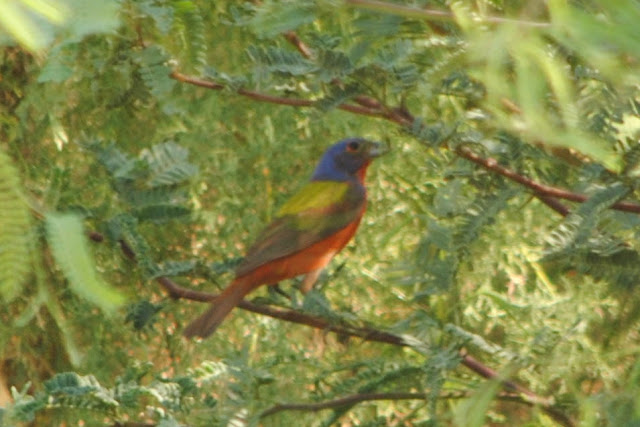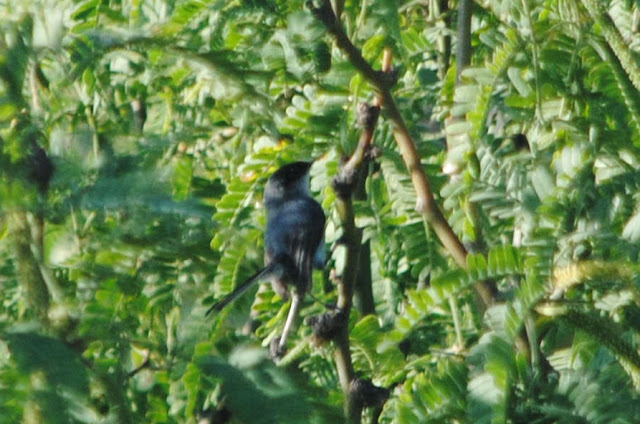Osprey
Once we started walking north along the road it didn't take us long to locate my target Yellow-billed.
Yellow-billed Cuckoo
We gave up trying to get better views of the cuckoo shortly after losing the bird. We then decided to look for our second target of the day, the Barn Owl. Somehow three of the four fledgling Barn Owls died and after finding bullet shells under where the fledglings were staying it kinda summed up my investigation. However, one of the fledglings survived and the parents are still healthy.
Barn Owl
After locating these birds we were content with our day, but we looked at the clock and saw that it was only 6:00A.M. and we still had nearly five hours left to bird! So, from the B and M we hiked east towards the west end of the Tres Rios Overbank Wetlands. On our way there we had to hike through a quarter mile of barren ground which is excellent for Lesser Nighthawks, we even found a female incubating two little brown eggs.
Lesser Nighthawk
After observing the nighthawks we hiked further to the west end of Tres Rios which has many mature cottonwoods. On our way we passed by a nice green area which looked like it would be good habitat for almost any eastern vagrant and I jokingly said "What if there was a Painted Bunting in this patch?!" We laughed at how unlikely that would be but I have been having a lot of luck when it comes to pointing out stuff like that, so who knows! Before long we reached the west end of Tres Rios where we picked up a few more awesome species, like two more Yellow-billed Cuckoos, a Bullock's Oriole, a few more Blue Grosbeaks, and Walker's overdue lifer Yellow-breasted Chat. While scanning the large trees in search of anything else we decided to hike towards 91st Avenue which is about 2.5 miles from the west end. While Walker and I were talking and laughing at dumb "bird jokes" I spied a super distant bird on the top of a mesquite tree. After putting my binocs on I thought of many birds in my head "Baltimore Oriole? No. Orchard Oriole? No. What the heck, Walker, I see a male Painted Bunting!!!!!!!"
Painted Bunting!!!!
For a split second Walker thought I was just joking with him, but once he saw that I was serious we both nearly had heart-attacks!! The PABU was in an area where we couldn't get any closer because the trees were too thick to see through, but we enjoyed our distant but unbelievably awesome discovery! The bird then popped down into the super thick jungle of mesquites and we then decided to move on and see if our blessed day would get any better. While Walker and I were hiking further along the road we were still in shock of the amazing bird and we couldn't stop saying "What the HECK!!!". Once we reached the area where the trail splits into two we took the other side of the trail back west. The first area we checked out was a thick jungle of willows. While we scanned the area a Barn Owl flushed and a flock of forty-some grackles came out of nowhere and nearly harassed the owl to death! We continued on our way back to the bunting when Walker walked up to the edge of some reeds and I quietly screamed "STOP!" Walker turned around as if I screamed bloody murder (which I probably did). I then pointed out a Least Bittern about ten feet away!
Least Bittern
Least Bitterns are always a treat to see and I never take them for granted. The first time I had good looks of a Least Bittern, I actually heard it giving a very strange call first and after scanning the area where the call was coming from for over five minutes I finally found the source of the sound and I nearly fell in the lake in astonishment! Since then I have seen MANY Least Bitterns and I always stop to look at this awesome marsh-dwelling heron. After observing one of my favorite birds we had to move on as the heat was starting to creep up on us a little ("a little" as in "a little" over 100 degrees!), and before reaching the bunting spot a flock of three Caspian Terns flew over!
Caspian Tern
After the terns flew over, Walker and I had to try to avoid seeing or hearing any other birds so that our brains wouldn't explode from birding too hard! But despite our attempt we couldn't stop from hearing the song of the male Painted Bunting creeping in our muffled ears! However, Walker and I endured the pain of our exploded brains (and the now 105 degree heat) and searched for the singing bunting once again. This time the bunting was a lot more cooperative and provided mind-blowing views!
Painted Bunting
For you readers who survived the mind blow here are a couple less shocking photos.
Painted Bunting
Seeing all of these awesome birds was awesome! The PABU took the cake, no doubt in any mind, while the owls, nighthawks, and cuckoos gave the cake the perfect amount of icing, but after adding the Osprey crush, the Least Bittern crush, and the Caspian Terns flying over, I think the cake was inedible, but I still took it and here I am alive and unhealthy! After the awesome half day of birding with Walker I returned to the B and M and Tres Rios a few days later to show Mr. Joe Ford and Mr. Paul Doucett the bunting. We didn't just find the bunting but had great views of a Great Horned Owl!
Painted Bunting
Great Horned Owl
Seeing the Great Horned was kinda like a welcome to the the owler's club. Why am I all the sudden a huge owl fan? Well you'll have to wait till my next post to find out. But until then keep those nocs in reach and "Bird HARD!!!"



































































